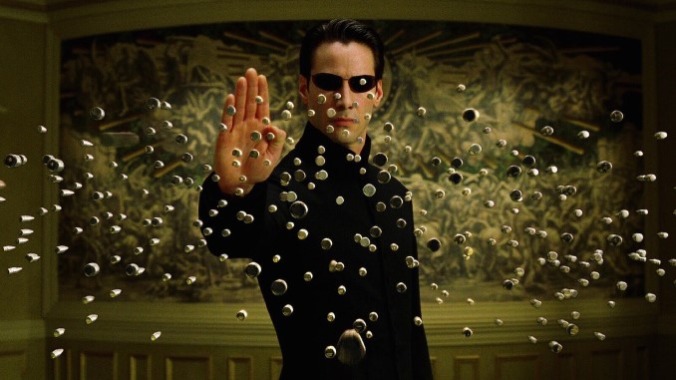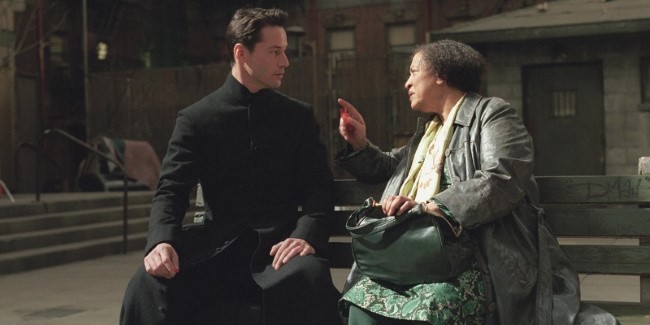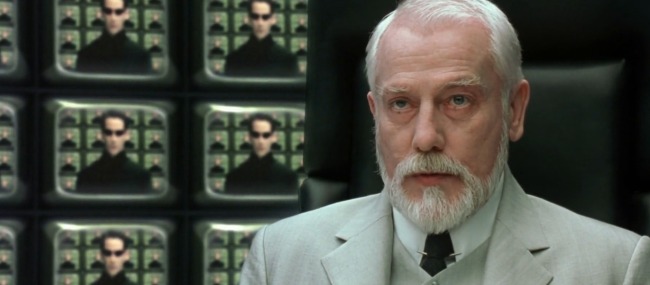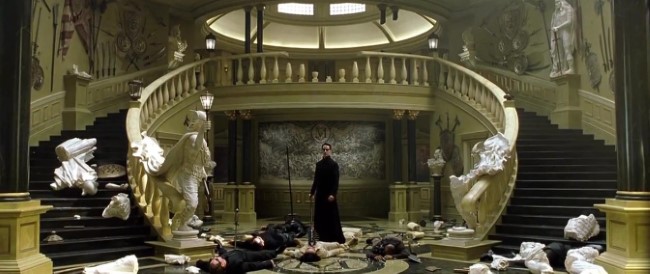
Hear Me Out is a column dedicated to earnest reevaluations of those cast-off bits of pop-cultural ephemera that deserve a second look. Whether they’re films, TV series, albums, comedy specials, videogames or even cocktails, Hear Me Out is ready to go to bat for any underappreciated subject.
It’s a curious thing when a major blockbuster has an extremely short window of primary relevance. Take The Matrix, Lana and Lilly Wachowski’s iconic sci-fi action spectacle, which tapped into William Gibson-style cyberpunk ideology and Hong Kong wuxia mysticism to deliver one of the seminal moments in late 1990s pop culture. That film arrived into a setting that had never seen anything like it (because no one saw Dark City, sadly), and immediately transformed pretty much all action cinema released in its wake. You really can’t stress enough how much aping of The Matrix happened in the next five years, as anyone who suffered through Ballistic: Ecks vs. Sever would surely attest. But what of The Matrix Reloaded?
The first sequel to the Wachowskis’ film was shot concurrently with “trilogy” capper The Matrix Revolutions, hit theaters in May of 2003, and was then chased by the supposedly climactic Revolutions less than six months later. Unlike the original film, which had roughly four years to build its lasting pop-cultural cache, Reloaded’s reputation as an individual work of art could really only be properly said to have existed from May to November, 2003. After that, what was it? A middle child, a bridge between the beloved original and a third film that quickly leapt from the rails and finally surrendered to the same nonsensical pretension that would infect The Matrix Resurrections two decades later. Just half a year after its release, it had already become practically impossible for rank-and-file theatergoers to judge The Matrix Reloaded on its own merits, ideologically chained as it was to the sinking ship of Revolutions. The suction of that third entry’s failings has subsequently dragged The Matrix Reloaded down into the pop-cultural abyss.
And that’s a shame, because The Matrix Reloaded is not only a brilliantly executed bit of sci-fi/action filmmaking, but also a worthy follow-up to so many of the ideas broached by the Wachowskis in 1999, from the battle between predestination and free will, to the placating nature of the heroic myth itself. It’s a sequel in the classic sense: Bigger, bolder, more ambitious and less restrained by good taste. It’s less ominously theatrical, more unabashedly action-packed. And for the length of its runtime, this works, deepening the mythos of The Matrix and the diabolical intelligence of its machine overlords, even as it delivers pulse-raising action spectacle. It’s only because the hand-off to the portentous Matrix Revolutions was bungled so thoroughly that it’s now become difficult for viewers to appreciate that Reloaded does a fine job of raising the stakes and setting up a climactic struggle for Neo to engage in. We simply, well … we never received the payoff that Reloaded promises. But that’s the fault of Revolutions, not this movie.

It all starts with Neo, whose character at the triumphant climax of The Matrix seems like a newborn god ready to effortlessly dismantle the shared illusion of this virtual reality system. The audience’s conception of The One’s true nature is limited, but we naturally assume that Neo’s ability to control this place will allow him to quickly unlock its mysteries as he peers behind the curtain. The Matrix Reloaded immediately puts that notion in its place, and Neo himself often seems surprised by the ambiguity. Perhaps he thought that being The One would come with a sudden rush of insight, some cosmic understanding of what exactly it is he’s supposed to do in order to usher in humanity’s next golden age. Instead, he finds that although he can easily pummel Agents in The Matrix, the mere ability to triumph over them doesn’t represent a lasting victory for those rebel humans living in Zion, threatened now by an army of machines digging ever closer to humankind’s last city. As it turns out, the systems of control at work here are a little bit more byzantine than something that can be solved with a solid punch. This undermining of the seeming confidence and triumph present in the close of The Matrix becomes one of Reloaded’s primary themes.
Consider how the film handles Morpheus, who instead of an all-knowing sage now suddenly feels like more of an audience proxy. In The Matrix, Morpheus arrives with the aura of a supernatural figure, a prophet who understands with absolute certainty that the vision of the future he’s been gifted–of The One’s return to throw off the shackles of machine oppression–is absolutely, unquestionably true. Morpheus is not a man who can be rattled; not someone who can be conquered, even by the mind-hacking of the agents when he is captured. And it’s because his will (powered by faith) is just too strong for that, wrapping him in a curtain of idealistic invincibility. The Matrix Reloaded shatters that invincibility by showing him that his precious One remains just another fallible human, in the process making the audience doubt the soundness of Morpheus’ mind, seeing as we now do that his main driver is something that is more or less akin to religious mania, a crutch he needs to motivate himself in the face of the end times. The Oracle whose predictions he trusted? She’s part of the system, and even if benevolent, she’s clearly playing her own game. His messiah? He’s just a man, one whose attachment to a single woman threatens his ability to even begin grasping the bigger picture. The Matrix Reloaded does a number on the previously unshakeable Morpheus, leaving him unsure of everything he previously held dear. As he puts it, paraphrasing the book of Daniel, “I have dreamed a dream, and now that dream has gone from me.”
It all leads to the film’s gut-punch of a reveal, delivered to Neo from the mouth of The Architect, at the very heart of The Matrix, the one place where Morpheus’ prophecy is meant to be realized. The very concept of The One is just another layer of control, a way the machines have devised to deal with a “systemic anomaly” that occasionally crops up to threaten the security of the system. Neo is no supernatural savior; he’s merely a rounding error in high-level math, a foreseen hiccup that has already been corrected before he’s even aware of what has happened. Belief in “The One,” in fact, is useful in placating the human population, who rally around a false savior rather than getting proactive or desperate to take the fight to the machines. It’s a rather remarkable piece of writing from the Wachowskis, to take a character they imbued with such cosmic significance and then pull the rug out from under him so cruelly. Like the heroes of other classic cinematic middle chapters, he must harden his resolve in the face of defeat. This moment of loss is unfortunately undercut by the decision in Revolutions to then lean right back into an almost supernatural, messianic stature to Neo in the real world.
 Here to burst your hero bubble.
Here to burst your hero bubble.
But of course, this is still a popcorn-munching action flick we’re talking about here, and The Matrix Reloaded absolutely shines in that regard, again far outclassing the convoluted, bloodless superhero-style battles that eventually come to dominate Revolutions. Here, the feel of the action is still more tied to the unique combination of wuxia wire work and John Woo-style gun-kata that the first film helped to popularize in the West, a style that still continues to evolve cinematically today through the likes of the John Wick series. What has evolved most dramatically in Reloaded from what we saw in 1999’s The Matrix is the complexity of Neo’s range of motion, incorporating a more balletic fluidity that is immediately put on display in his first battle with a trio of “upgraded” agents, whom he smashes in short order. As his understanding of The Matrix grows, so does his ability to move in ways well outside the realm of human possibility, and more in line with the world of fantasy.
The Matrix Reloaded, however, catches Neo at a particularly satisfying moment in this action evolution, going out of its way to reinforce the knowledge that he is indeed still human–still flesh and blood–even as it shows him capable of incredible feats. Note the drops of blood, after he stops a blade with his bare hand during the battle with The Merovingian’s soldiers, which provides just enough reasonable doubt for the audience to fear for Neo’s safety. He may be able to gracefully float between balconies in the sprawling, weapons-based brawl that follows, but we know he’s still vulnerable. This is the sort of pathos eventually lost in Revolutions’ rain-slicked, overly stylized battle between Neo and Smith, which dispenses with any remaining ties to reality, instead substituting intangible power creep. Each piece of hand-to-hand combat in Reloaded is more satisfying because it retains at least some element of Neo’s humanity. He hasn’t metaphorically shaken off every bit of that subway tunnel dust from 1999, not yet.

With that said, Neo isn’t even involved in the film’s greatest action sequence, the epic freeway chase that sees Trinity and Morpheus attempting to abscond with The Keymaker while both agents of the system and The Merovingian’s ghostly twins are in hot pursuit. It’s a scene of incredible precision and James Cameron-esque vehicular carnage, made possible only by the construction of a 1.5-mile stretch of simulated freeway, built on decommissioned runways at the Naval Air Station of Almeda, California. This blank check of a setting allows for one of the most complex, expensive and thrilling action setpieces of the decade, threading motorcycles through the twisted metal of car collisions, swordplay and bullet spray, culminating in the head-on collision (and fusion, really) of two semi trucks barreling down the freeway directly at each other. It’s such a grandiose moment of destruction that even MythBusters couldn’t help but recreate it a few years later … in the same location, no less. Our human need for over-the-top destruction must be appeased, and it made for a great pairing with popcorn in the spring of 2003.
Today, it is unfortunate how the identity of The Matrix Reloaded has been subsumed into a franchise identity bogged down by two more inferior sequels, having forever lost its chance to stand alone as an individual work. Perhaps if there had been a bigger gap between Reloaded and the release of Revolutions, the same film might register more of an impression today. As it is, it often feels like it is now remembered chiefly in the form of memes playing off elements such as The Architect’s hyper-analytical dialect, or snide commentary on its now dated use of CGI in sequences like the Neo vs. Smith “burly brawl.” In truth, it feels absurd on some level to highlight the cultural disappearing act of a film that made $741 million at the box office and became the highest grossing R-rated film of all time, because it seems impossible that any film viewed so widely at the time could slip from the cultural consciousness. But as in the case of other filmic middle children, that’s just what happened. The crumbling of The Matrix as a franchise has obscured the best elements of its best sequel.
For six months in 2003, though, the promise of a grand conclusion to the Wachowskis’ story gleamed on the horizon, thanks to the deepening mythos so effectively established within The Matrix Reloaded. Perhaps in the better version of our current cultural simulation, we even received it.
Jim Vorel is a Paste staff writer and resident genre geek. You can follow him on Twitter for more film and TV writing.